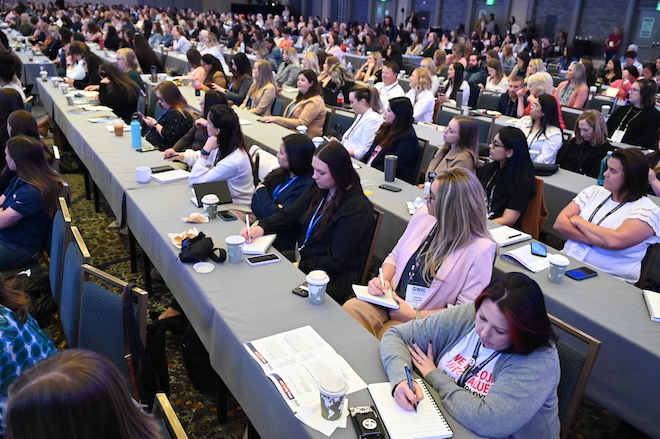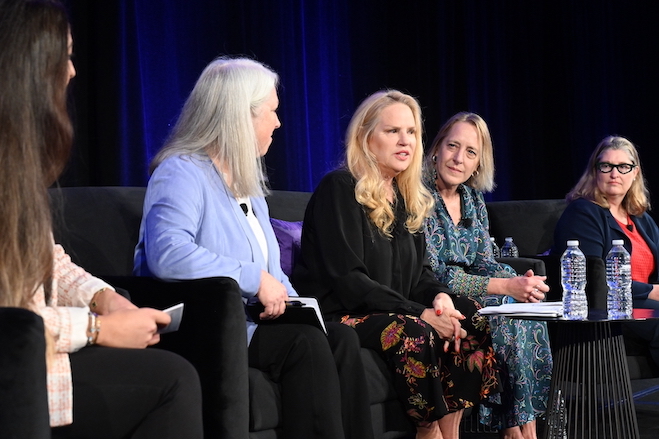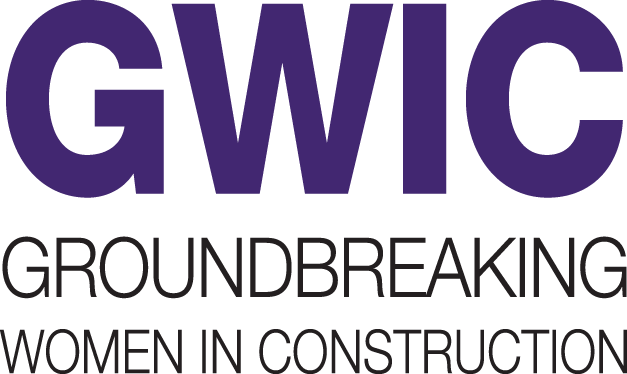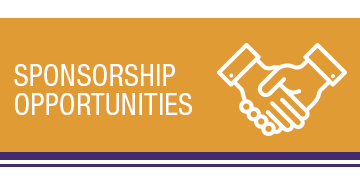Even With More Bumps and Risks, Women Leaders Push Industry Forward

Industry CEOs Carey Smith of Parsons Corp. (left) and Linda Alvarado of Alvarado Construction Inc. urged 950 attendees of the recent Groundbreaking Women in Construction conference, sponsored by ENR and Peckar & Abramson, to challenge the status quo in leading diversity and inclusion impact
Credit: Les Kamens/The Photo Group
New levels of project funding are adding more opportunities in construction but also new risks in keeping project costs and schedules under control. To meet the demand for industry transformation in fast-changing markets, women are moving quickly to innovate in leadership and in diversity and inclusion impact.
At the Groundbreaking Women in Construction conference, held May 11-12 in San Francisco and marking its 20th year, panelists outlined change in infrastructure missions driven by recent federal laws generating hundreds of billions of dollars in new investment.
Minelly De Coo, deputy infrastructure director for New York Gov. Kathy Hochul (D), told more than 950 attendees at the event, sponsored by ENR and law firm Peckar & Abramson, that the state has received $10 billion in infrastructure investment law funds so far. She noted new funding for the $16-billion Gateway rail megaprogram to upgrade a critical Northeast Corridor link, but also $3 billion dedicated to reconnecting communities and tackling other infrastructure inequity, as well as $1 billion to expand broadband capacity, particularly in underserved areas.
Carol Haddock, Houston Public Works director, said funds are making a “huge difference” in its $2.7-billion budget for needed upgrades that require more community engagement. “Diversity is not the goal. Inclusion is the goal,” she said.
Adding Needed Talent
“As we’re making historically high investments in infrastructure and toward the energy transition, this is the moment in time to really embrace socioeconomic and justice considerations so we can reverse or undo historical and generational patterns that unfortunately are embedded in our systems.”
Deepa Poduval, Black & Veatch senior vice president and sustainability lead
Women managers also noted new attention to how sustainability intersects with diversity and equity. Arup Principal Erin McConahey led an effort to perform whole-life carbon assessments on the firm’s global building portfolio of 950 assets in 30 countries “because we didn’t know what the carbon emissions were that our professional services were responsible for,” she says. It found the project impact “is 350 times the carbon emissions” than those from firm operations.
“As we’re making historically high investments in infrastructure and toward the energy transition, this is the moment in time to really embrace socioeconomic and justice considerations so we can reverse or undo historical and generational patterns that unfortunately are embedded in our systems,” said Deepa Poduval, Black & Veatch senior vice president and sustainability lead.
Women also are rising in key industry career areas to add needed experience and perspective to meet rising risk challenges—such as keeping project costs under control and schedules on track despite growing inflation, supply chain gaps and labor shortfalls, said a panel of women executives in risk management—a field they noted has not always been welcoming to diverse participants.
"We've had projects pushed aside because we can't get the subcontractors to hold the pricing for long," saod Beverly Hill, Balfour Beatty risk management vice president. "Lenders want to have certainty of cost, but you can't nail them down, and you're not dealing with your regular suppliers, you may be dealing with a third, fourth or fifth set instead of your first, second or third because everyone has so much work."
About half of clients of MOCA Systems, an owner project delivery consultant, are considering changing project schedules based on supply chain or labor impacts, "which is a pretty big deal," said firm CEO Sandy Hamby. "The uncertainty exists in the owner arena, and of course it flows down to all of us."
Michele Luster, risk manager for contractor Swinterton, said it's critical for firms to insure project team members to fully understand the pressures facing projects and working with them to develop solutions "to really build a culture that is sensitive to risk."
Field work and project site leadership roles also offer a key career growth path for women eager to take on the challenges of those roles in the current market.
Executives of non-profit groups Bridges to Prosperity and Engineers Without Borders—which have used thousands of industry volunteers, including professional and student engineers, for global field projects over the last two decades—noted how these experiences matter for participants to learn how to work effectively with underserved communities and in building leadership confidence employers need. Both groups are strongly supported by industry firms.
 More than 950 attendees at the Groundbreaking Women in Construction event focused on career benefits and risks from new levels of infrastructure investment Photo by Les Kamens/The Photo Group
More than 950 attendees at the Groundbreaking Women in Construction event focused on career benefits and risks from new levels of infrastructure investment Photo by Les Kamens/The Photo Group
Bridges to Prosperity works to build local bridges "where heavy equipment can't go," said CEO Nivi Sharma, who added that while it "sounded like a white savior program" when she joined its management team, the group is "studious about measuring impact ... and producing data that helps governments make better decisions" in prioritizing infrastructure investment. Its projects have linked more than 1.6 million people, she said.
Engineers Without Borders COO Clare Haas Claveau, noting the group's major focus also on U.S. work, said a recent effort by Pittsburgh area volunteers to use a small government grant to upgrade a road for emergency services, gained $100,000 in new funding to finish work after turning in their project report.
Women participants are key, making up 40% of EWB membership, said Claveau, a civil engineer. "A lot of our project teams are led by women," she said. "We are working to keep these women in engineering." Sharma noted that one Rwanda bridge project had nearly a 40% female community workforce. "It's normally much less, and people are suspicious of them," she said, "But girls are watching and see opportunity ahead."
Former laborer Maria Inlow, now director of environmental health and safety at Skanska USA Buildings, noted much difficulty not too long ago, “just finding a pair of boots that fit me.” Saria Gwin-Maye, a Cincinnati ironworker with 34 years of experience who was a guest of President Joe Biden at this year’s State of the Union address, had faced added difficulty earlier in her career to balance work demands with those of being a single mother.
But women who have pursued field project experience and top roles say that despite challenges, their leadership skills and careers have benefitted greatly. Amanda McCarthy and Tasha Sherbanuk, both Fluor Corp. construction management veterans of the $14-billion LNG Canada natural gas project in upper British Columbia, say experience at the site equipped them to take on higher level management roles.
“Women bring a very different dynamic when we are there,” said McCarthy, who now is lead Fluor manager of a critical minerals project in Arizona. “We are in a very different world than where we were 20 or 30 years ago. We have to be more compassionate leaders, and I think that we are actually helping men change how they look at things.”
Intention to Impact
To build careers for women in construction, the industry needs to move beyond diversity intention to having it make a long term impact.
Brian Dowd, senior vice president and group manager for California at Granite, shared an interview he did years ago with a “phenomenal young African American woman with internships and a masters in civil engineering.” She turned down his job offer, noting that compensation was not the issue, he said. According to Dowd, the woman said she "looked around and just didn’t see anybody I could hang out with.” He added, “That was the wakeup call that launched me on a journey to shift things.”
 Construction risk managers in owner, contractor and consultant firms shared strategies for coping with new levels of project financial, supply and execution uncertaintiy.
Construction risk managers in owner, contractor and consultant firms shared strategies for coping with new levels of project financial, supply and execution uncertaintiy. Photo by Les Kamens/The Photo Group
Zyla Doria, an WSP assistant vice president and design project manager for three stations of San Francisco Municipal Transportation Agency's central subway, told the story of working for a contractor early in her career—now out of business—where she was catcalled, harassed in the field and paid significantly less than male peers, even some she was training. It led to what she calls a “career pivot” to design work and earning a P.E. license.
Sarah Narjes, Mortenson general manager in Salt Lake City, described a broad-based industry effort to share best practices on diversity, equity and inclusion similar collaboration to improve jobsite safety. Seven firms started a nonprofit called Construction Inclusion Week two years ago, set up to unite industry "around actually making change,” she said. “Participants dedicate an entire week to education—creating a space for conversation and movement.” Mortenson chairs the event this year, to take place Oct. 16-20, with a focus on commitment and accountability, belonging and supplier diversity.
Doing the Unorthodox
Women who have persevered to top industry decisionmaker level offered attendees some strategy, and unorthodox steps taken, to power through the status quo.
Linda Alvarado, CEO of large Colorado-based commercial builder Alvarado Construction Inc., president of restaurant company Palo Alto Inc. and the first female and first Hispanic co-owner of a major league baseball team, the Colorado Rockies, recalled trying to wear a hardhat like her peers after founding her construction firm at age 24.
"in reality, what I had to sell was credibility, commitment, character, capability, cashflow and the willingness to do some things,” she said. “The point of differentiation is brains, not brawn … whether it’s design, engineering, architecture or on the ground, [the key] is embracing change and changing technology.”
 State and local infrastructure managers noted challenges in integrating new infusions of federal investment to execute projects and engage communities in development.
State and local infrastructure managers noted challenges in integrating new infusions of federal investment to execute projects and engage communities in development. Photo by Les Kamens/The Photo Group
Carey Smith also embraced technology innovation to transform Parsons Corp. from an old line engineer founded nearly 80 years ago to a U.S. leader in high-tech and advanced infrastructure services to public and private clients. As chair, president and CEO, she has reshaped the firm’s culture and diversity outlook, which has helped propel it into a $4.2-billion revenue giant with 17,000 global employees working in 23 countries—the largest publicly-owned AEC firm run by a woman.
But noted Smith, a degreed electrical engineer, women make up just 47% of the workforce and just 25% of those in industry C-suites roles. "This industry is slow and needs to catch up,” she said.
Maria Lehman, current president of the American Society of Civil Engineers, said women hold eight of its board positions, but "numbers are sliding back” for women engineers entering and staying in the industry nationally, she also cautioned.
“At Parsons, we hold ourselves accountable, and we have tied our incentives to how we’re doing on racial diversity and gender diversity,” Smith told conference attendees. “I hired and interviewed the best, and if you do that, it’s amazing the diversity you get, because you aren’t even thinking about it. You’re really putting in place the best people.”
She added: “If you’re paying for performance, you’ll find that there is a lot of diversity in your top performers.”
By Debra K. Rubin, with Jen Seward, Aileen Cho, Janice L.Tuchman, Scott Blair, Alisa Zevin and Emell Adolphus in San Francisco











